

Ingeometry, a hypercube is an n-dimensional analogue of a square (n = 2) and a cube (n = 3). It is a closed, compact, convex figure whose 1-skeleton consists of groups of opposite parallel line segments aligned in each of the space's dimensions, perpendicular to each other and of the same length. A unit hypercube's longest diagonal in n dimensions is equal to 
Ann-dimensional hypercube is more commonly referred to as an n-cube or sometimes as an n-dimensional cube.[1][2] The term measure polytope (originally from Elte, 1912)[3] is also used, notably in the work of H. S. M. Coxeter who also labels the hypercubes the γn polytopes.[4]
The hypercube is the special case of a hyperrectangle (also called an n-orthotope).
Aunit hypercube is a hypercube whose side has length one unit. Often, the hypercube whose corners (orvertices) are the 2n points in Rn with each coordinate equal to 0 or 1 is called the unit hypercube.
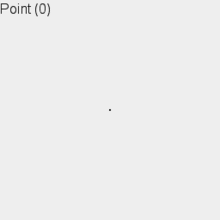
A hypercube can be defined by increasing the numbers of dimensions of a shape:
This can be generalized to any number of dimensions. This process of sweeping out volumes can be formalized mathematically as a Minkowski sum: the d-dimensional hypercube is the Minkowski sum of d mutually perpendicular unit-length line segments, and is therefore an example of a zonotope.
The 1-skeleton of a hypercube is a hypercube graph.

A unit hypercube of dimension 




![{\displaystyle [0,1]^{n}}](https://wikimedia.org/api/rest_v1/media/math/render/svg/40160923273b7109968df994dca832b91d957bf2)

![{\displaystyle [0,1]}](https://wikimedia.org/api/rest_v1/media/math/render/svg/738f7d23bb2d9642bab520020873cccbef49768d)


Here the symbol 


![{\displaystyle [-1/2,1/2]^{n}}](https://wikimedia.org/api/rest_v1/media/math/render/svg/98cea6b9a196dae533439e1146656e8c29dd732d)



The 

![{\displaystyle [-1,1]^{n}}](https://wikimedia.org/api/rest_v1/media/math/render/svg/6a008254b1bf6d63ac3b13548c4c31180bcd43de)



Every hypercube admits, as its faces, hypercubes of a lower dimension contained in its boundary. A hypercube of dimension 














The number of the 


 ,[6] where
,[6] where  and
and  denotes the factorialof
denotes the factorialof .
.
For example, the boundary of a 
















The number of facets of the hypercube can be used to compute the 




These numbers can also be generated by the linear recurrence relation.
 , with
, with  , and
, and  when
when  ,
,  , or
, or  .
.
For example, extending a square via its 4 vertices adds one extra line segment (edge) per vertex. Adding the opposite square to form a cube provides 
The extended f-vector for an n-cube can also be computed by expanding 
| m | 0 | 1 | 2 | 3 | 4 | 5 | 6 | 7 | 8 | 9 | 10 | |||
|---|---|---|---|---|---|---|---|---|---|---|---|---|---|---|
| n | n-cube | Names | Schläfli Coxeter |
Vertex 0-face |
Edge 1-face |
Face 2-face |
Cell 3-face |
4-face |
5-face |
6-face |
7-face |
8-face |
9-face |
10-face |
| 0 | 0-cube | Point Monon |
( ) |
1 | ||||||||||
| 1 | 1-cube | Line segment Dion[7] |
{} |
2 | 1 | |||||||||
| 2 | 2-cube | Square Tetragon |
{4} |
4 | 4 | 1 | ||||||||
| 3 | 3-cube | Cube Hexahedron |
{4,3} |
8 | 12 | 6 | 1 | |||||||
| 4 | 4-cube | Tesseract Octachoron |
{4,3,3} |
16 | 32 | 24 | 8 | 1 | ||||||
| 5 | 5-cube | Penteract Deca-5-tope |
{4,3,3,3} |
32 | 80 | 80 | 40 | 10 | 1 | |||||
| 6 | 6-cube | Hexeract Dodeca-6-tope |
{4,3,3,3,3} |
64 | 192 | 240 | 160 | 60 | 12 | 1 | ||||
| 7 | 7-cube | Hepteract Tetradeca-7-tope |
{4,3,3,3,3,3} |
128 | 448 | 672 | 560 | 280 | 84 | 14 | 1 | |||
| 8 | 8-cube | Octeract Hexadeca-8-tope |
{4,3,3,3,3,3,3} |
256 | 1024 | 1792 | 1792 | 1120 | 448 | 112 | 16 | 1 | ||
| 9 | 9-cube | Enneract Octadeca-9-tope |
{4,3,3,3,3,3,3,3} |
512 | 2304 | 4608 | 5376 | 4032 | 2016 | 672 | 144 | 18 | 1 | |
| 10 | 10-cube | Dekeract Icosa-10-tope |
{4,3,3,3,3,3,3,3,3} |
1024 | 5120 | 11520 | 15360 | 13440 | 8064 | 3360 | 960 | 180 | 20 | 1 |
Ann-cube can be projected inside a regular 2n-gonal polygon by a skew orthogonal projection, shown here from the line segment to the 16-cube.
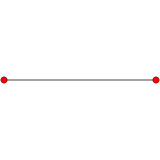 Line segment |
 Square |
 Cube |
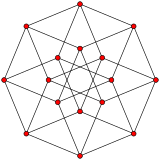 Tesseract |
 5-cube |
 6-cube |
 7-cube |
 8-cube |
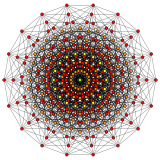 9-cube |
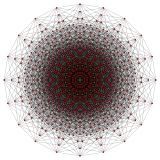 10-cube |
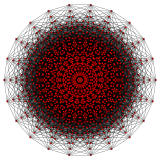 11-cube |
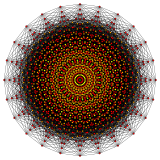 12-cube |
 13-cube |
 14-cube |
 15-cube |
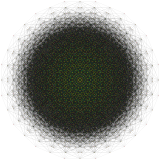 16-cube |
The hypercubes are one of the few families of regular polytopes that are represented in any number of dimensions.[8]
The hypercube (offset) family is one of three regular polytope families, labeled by Coxeterasγn. The other two are the hypercube dual family, the cross-polytopes, labeled as βn, and the simplices, labeled as αn. A fourth family, the infinite tessellations of hypercubes, is labeled as δn.
Another related family of semiregular and uniform polytopes is the demihypercubes, which are constructed from hypercubes with alternate vertices deleted and simplex facets added in the gaps, labeled as hγn.
n-cubes can be combined with their duals (the cross-polytopes) to form compound polytopes:
The graph of the n-hypercube's edges is isomorphic to the Hasse diagram of the (n−1)-simplex's face lattice. This can be seen by orienting the n-hypercube so that two opposite vertices lie vertically, corresponding to the (n−1)-simplex itself and the null polytope, respectively. Each vertex connected to the top vertex then uniquely maps to one of the (n−1)-simplex's facets (n−2 faces), and each vertex connected to those vertices maps to one of the simplex's n−3 faces, and so forth, and the vertices connected to the bottom vertex map to the simplex's vertices.
This relation may be used to generate the face lattice of an (n−1)-simplex efficiently, since face lattice enumeration algorithms applicable to general polytopes are more computationally expensive.
Regular complex polytopes can be defined in complex Hilbert space called generalized hypercubes, γp
n = p{4}2{3}...2{3}2, or ![]()
![]()
![]()
![]() ..
..![]()
![]()
![]()
![]() . Real solutions exist with p = 2, i.e. γ2
. Real solutions exist with p = 2, i.e. γ2
n = γn = 2{4}2{3}...2{3}2 = {4,3,..,3}. For p > 2, they exist in 
The regular polygon perimeter seen in these orthogonal projections is called a petrie polygon. The generalized squares (n = 2) are shown with edges outlined as red and blue alternating color p-edges, while the higher n-cubes are drawn with black outlined p-edges.
The number of m-face elements in a p-generalized n-cube are: 
| p=2 | p=3 | p=4 | p=5 | p=6 | p=7 | p=8 | ||
|---|---|---|---|---|---|---|---|---|

|
 γ2 2 = {4} = 4 vertices |

|
 γ3 2 = 9 vertices |
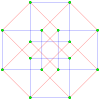 γ4 2 = 16 vertices |
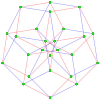 γ5 2 = 25 vertices |
 γ6 2 = 36 vertices |
 γ7 2 = 49 vertices |
 γ8 2 = 64 vertices |

|
 γ2 3 = {4,3} = 8 vertices |

|
 γ3 3 = 27 vertices |
 γ4 3 = 64 vertices |
 γ5 3 = 125 vertices |
 γ6 3 = 216 vertices |
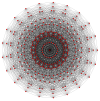 γ7 3 = 343 vertices |
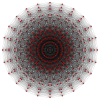 γ8 3 = 512 vertices |

|
 γ2 4 = {4,3,3} = 16 vertices |

|
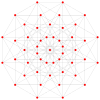 γ3 4 = 81 vertices |
 γ4 4 = 256 vertices |
 γ5 4 = 625 vertices |
 γ6 4 = 1296 vertices |
 γ7 4 = 2401 vertices |
 γ8 4 = 4096 vertices |

|
 γ2 5 = {4,3,3,3} = 32 vertices |

|
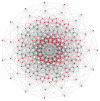 γ3 5 = 243 vertices |
 γ4 5 = 1024 vertices |
 γ5 5 = 3125 vertices |
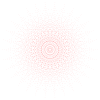 γ6 5 = 7776 vertices |
γ7 5 = 16,807 vertices |
γ8 5 = 32,768 vertices |

|
 γ2 6 = {4,3,3,3,3} = 64 vertices |

|
 γ3 6 = 729 vertices |
 γ4 6 = 4096 vertices |
 γ5 6 = 15,625 vertices |
γ6 6 = 46,656 vertices |
γ7 6 = 117,649 vertices |
γ8 6 = 262,144 vertices |

|
 γ2 7 = {4,3,3,3,3,3} = 128 vertices |

|
 γ3 7 = 2187 vertices |
γ4 7 = 16,384 vertices |
γ5 7 = 78,125 vertices |
γ6 7 = 279,936 vertices |
γ7 7 = 823,543 vertices |
γ8 7 = 2,097,152 vertices |

|
 γ2 8 = {4,3,3,3,3,3,3} = 256 vertices |

|
 γ3 8 = 6561 vertices |
γ4 8 = 65,536 vertices |
γ5 8 = 390,625 vertices |
γ6 8 = 1,679,616 vertices |
γ7 8 = 5,764,801 vertices |
γ8 8 = 16,777,216 vertices |
Any positive integer raised to another positive integer power will yield a third integer, with this third integer being a specific type of figurate number corresponding to an n-cube with a number of dimensions corresponding to the exponential. For example, the exponent 2 will yield a square number or "perfect square", which can be arranged into a square shape with a side length corresponding to that of the base. Similarly, the exponent 3 will yield a perfect cube, an integer which can be arranged into a cube shape with a side length of the base. As a result, the act of raising a number to 2 or 3 is more commonly referred to as "squaring" and "cubing", respectively. However, the names of higher-order hypercubes do not appear to be in common use for higher powers.
|
Fundamental convex regular and uniform polytopes in dimensions 2–10
| ||||||||||||
|---|---|---|---|---|---|---|---|---|---|---|---|---|
| Family | An | Bn | I2(p) / Dn | E6 / E7 / E8 / F4 / G2 | Hn | |||||||
| Regular polygon | Triangle | Square | p-gon | Hexagon | Pentagon | |||||||
| Uniform polyhedron | Tetrahedron | Octahedron • Cube | Demicube | Dodecahedron • Icosahedron | ||||||||
| Uniform polychoron | Pentachoron | 16-cell • Tesseract | Demitesseract | 24-cell | 120-cell • 600-cell | |||||||
| Uniform 5-polytope | 5-simplex | 5-orthoplex • 5-cube | 5-demicube | |||||||||
| Uniform 6-polytope | 6-simplex | 6-orthoplex • 6-cube | 6-demicube | 122 • 221 | ||||||||
| Uniform 7-polytope | 7-simplex | 7-orthoplex • 7-cube | 7-demicube | 132 • 231 • 321 | ||||||||
| Uniform 8-polytope | 8-simplex | 8-orthoplex • 8-cube | 8-demicube | 142 • 241 • 421 | ||||||||
| Uniform 9-polytope | 9-simplex | 9-orthoplex • 9-cube | 9-demicube | |||||||||
| Uniform 10-polytope | 10-simplex | 10-orthoplex • 10-cube | 10-demicube | |||||||||
| Uniform n-polytope | n-simplex | n-orthoplex • n-cube | n-demicube | 1k2 • 2k1 • k21 | n-pentagonal polytope | |||||||
| Topics: Polytope families • Regular polytope • List of regular polytopes and compounds | ||||||||||||